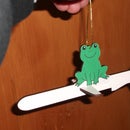Introduction: Circular Saw Cutting Guides
A decent hand-held circular saw can give a good, clean cut, but setting up to cut several pieces the same is very slow.
Measure, setup, measure again, check, measure again, check, pray is my usual process.
These guides are a pair of adjustable offset guides to allow me to set up a desired size of piece to cut from a sheet of ply and then very quickly repeat the cut to produce several pieces exactly the same size.
I did this using a quick and dirty fixed-size piece when I made some shelves and was so amazed at how much faster the cutting was that I decided to make these adjustable guides.
Step 1: Cut the Wood to Length
I had a spare strip of 18mm (3/4") ply about 80mm by a metre (3" by a yard) so that would be long enough to act as a jig for pieces up about half that width, while not being too awkward to keep in the workshop.
Cut the long piece in half, and then get a couple of chunks of similar (no need to be identical here) thickness and make the moveable end-stops.
Once the cuts had been made, I used an 80 grit paper to get rid of splinters.
Step 2: Cut the Slot
The key for the jigs is the slot for adjusting the end-stop.
I was going to use some M6 bolts, so the slot had to be at least that wide.
I was going to cut the slot out with a jigsaw, so the size of the jigsaw blade meant that drilling a 10mm (3/8") hole would allow ingress.
The holes were drilled equidistant from the end and sides and then pencil lines were marked between them.
Once a suitable way of holding the piece was worked out, the cuts were made, and then cleaned up with some sandpaper.
Step 3: Add Hard Contact Surfaces
Since the edge of plywood is quite soft and susceptible to knocks, I added a layer of hardwood to the surfaces which would be taking contact with the workpiece and saw guide.
This is the same deal as most of my other projects which involve wood whose appearance matters. Cut pieces oversize and hold them in place with masking tape. Then use lots of clamps and leave the glue to cure.
Step 4: Clean Up
Once the glue had cured, I planed the laminate down to the thickness of the plywood and then cut the horns off with a razor saw.
Surface markings from the clamps were taken off with sandpaper, and a pencil eraser cleaned all the remaining markings from the timber, and also did a fairly good job of cleaning off the dirt which had accumulated on the ply while it lay in the scrap box.
Step 5: Mounting Holes
Offer up the moving end-stop, mark through the slot and drill a hole. This doesn't really deserve a full step, but it didn't seem to fit logically in any of the other sections.
Step 6: Stain and Varnish
Cabot's Stain and Varnish (other such products are available). Needs a lot of stirring, but gives a good finish without too much skill or effort.
I made a rack from some wire which held the pieces hanging in mid-air which mean that I could cover all surfaces at the one time.
A delicate sand between coats and then the wood was ready.
Step 7: Assemble
These jigs should be adjustable, but solid, so I used wing-nuts to allow for one-handed tool-free tightening, while also providing a pretty strong grip.
A wider selection of washers would give a neater result, but the big fender washers were chosen to spread the load across the cut channel, while the smaller washers underneath were adequate for the non-moving location.
Step 8: Calibrate
To help with future cuts, I set both guides up at 50mm and made two little nicks in a piece of scrap with the circular saw.
Then I printed out some labels to give the offsets for inside and outside cuts using the aluminium (aluminum) saw guide which I use. Since I sometimes use metric and sometimes imperial, I printed labels with both measurements.
The key to this gadget is not accuracy, but repeatability: a piece of furniture which is 0.5mm (1/64") bigger than planned is much less annoying than one which has a 0.5mm (1/64") gap in a joint.
Step 9: Use
To use the guides, decide what size of wood is needed, and then subtract the relevant distance (demoed in previous section).
Set up one guide carefully (which takes time to check and re-measure).
Offer the other guide up and slide the end-piece to mate which duplicates the measurement precisely.
Make sure the wing-nuts are tight, then clamp to the workpiece and use the guides to position the saw guide.
I could not believe how much quicker cutting multiple pieces became once I had physical contact to confirm positioning, and I hope that you find this makes your cutting quicker too.













